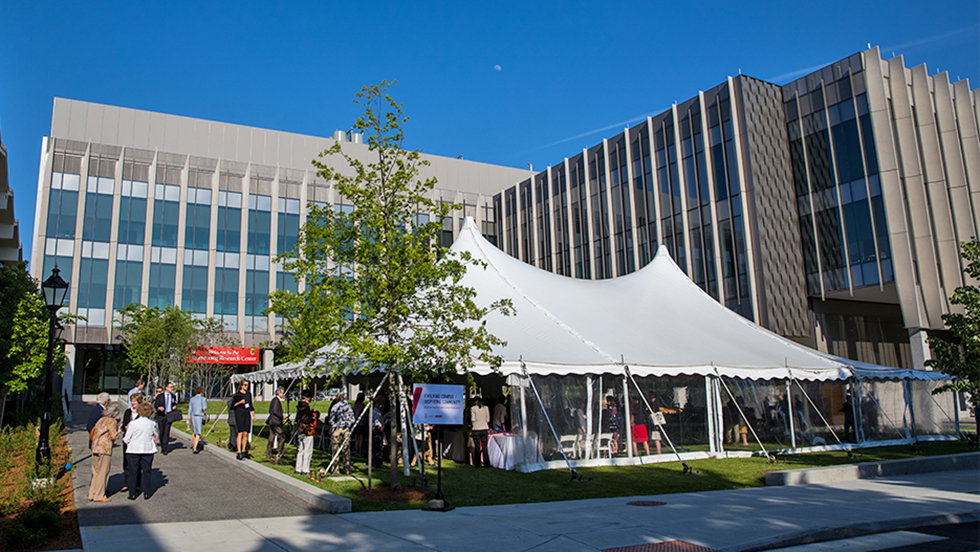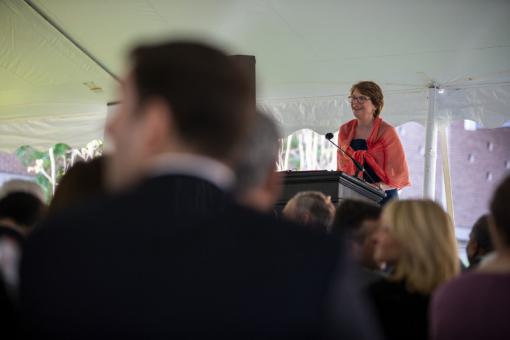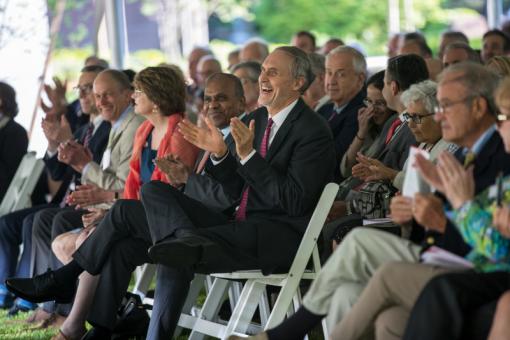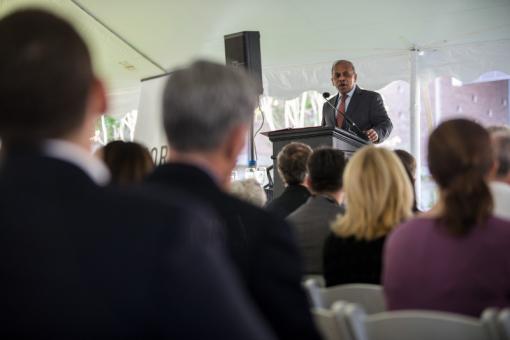
Members of the Brown community gathered on Giancarlo Plaza to dedicate Brown's new Engineering Research Center.
Credit: All Photos: Nick Dentamaro
The new facility, the product of five years of planning, design and construction, will enable the expansion of research and teaching in the School of Engineering.
Kicking off a weekend of celebration surrounding Brown's 250th commencement, members of the Brown community gathered on Thursday, May 24, to dedicate the University's new Engineering Research Center (ERC).
The three-story, 80,000-square-foot structure is home to specialized research facilities for nanoscale and biomedical engineering, along with two full floors of new lab space designed to expand research in renewable energy, environmental engineering, advanced materials and other areas. In total, 15 faculty research groups, 20 research associates and 80 graduate students will call the ERC home.
"It seems fitting that we're officially dedicating this building over Commencement and Reunion Weekend," said Brown Chancellor Samuel Mencoff in making the formal dedication on behalf of the Brown Corporation. "Brown's strength in engineering is built on generations of innovative alumni and dedicated faculty members. The completion of this project signals Brown's enduring commitment to educating and preparing the most creative leaders in the field to seek solutions to some of the world's most important social challenges."
University President Christina Paxson said the dedication was more than a mere celebration — it was an affirmation of engineering as a cornerstone of Brown's research and teaching mission.

Brown President Christian Paxson thanked the donors and volunteers who made the new building possible."This building is a statement about the importance of engineering at Brown and also in the world at large," Paxson said. "We need to blend engineering with a keen appreciation and understanding of the humanities, ethics and social sciences. I think that Brown can do this better than anyone. And I'm very excited to see the work that takes place here."
Mencoff and Paxson thanked the volunteers and donors who made the $88 million project possible, including lead gifts from Theresia Gouw, Charles Giancarlo, and Joan and Paul Sorensen. To date, the BrownTogether campaign has raised more than $142 million for engineering at Brown, Paxson said.
The new space will help to accommodate an expanding research and teaching enterprise in the School of Engineering. Since 2010, the faculty has grown by more than 25 percent, undergraduate enrollment has increased by 30 percent and the number of graduate students has more than doubled.
Collaborative space
Construction on the new facility was completed in October, two years almost to the day after Brown broke ground on the project. Since then, faculty and students have been moving in, and research in the new building is already underway.
The ERC was designed specifically to accommodate the collaborative approach to research in the School of Engineering. The open-plan research labs encourage cross-talk within and between labs. And the building's location in the heart of campus will encourage and enable collaborations the nearby Division of Applied Mathematics as well as the departments of chemistry, physics, computer science and earth, environmental and planetary sciences.
The Hazeltine Commons on the building's first floor and Giancarlo Plaza, a green space that unfurls outside the building's front doors, are designed to build a thriving intellectual community for faculty and students from across campus.
The ERC's state-of-the-art facilities include a 4,000-square-foot nanotechnology clean room, as well as a second clean room tailored for biomedical applications. A new imaging suite will advance research materials science, solid mechanics and other research areas. A new undergraduate teaching lab will expand course offerings and hands-on learning experience for a growing student body.

Dean Larry Larson says he looks forward to years of cutting-edge research in the new facility.The new facility provides a pristine research environment for high-precision, high-impact research. It's built on a solid concrete slab that minimizes vibrations from passing traffic that can disrupt nanoscale measurements. Stray electromagnetic fields are actively canceled to prevent interference with sensitive equipment.
"We have a lot of work to do solving problems of human disease, creating sustainable energy, healing our environment and bridging the digital divide," Sorensen Family Dean of Engineering Larry Larson said at Thursday's event. "But if you focus great people on these challenges and put them in a great laboratory space, magic will happen. This Engineering Research Center we dedicate today guarantees that this magic will happen here at Brown in the years and decades ahead."
The challenges ahead
The event's keynote was delivered by Subra Suresh, president of Nanyang Technological University (NTU) in Singapore. Suresh started his career as an engineering researcher and educator when he joined the Brown faculty as an assistant professor in 1983. He went on to become dean of engineering at MIT, director of the National Science Foundation and president of Carnegie Mellon University before taking the helm at NTU early this year.
Suresh cited a pair of reports issued in 2000 by the National Academy of Engineering, which enumerated the 20 greatest engineering achievements of the 20th century and the 14 grand challenges for the 21st century. It was hard not to notice, Suresh said, that many of the grand challenges — which included protecting nuclear armaments, securing cyberspace and confronting climate change — grew directly out of the 20th century's greatest achievements.
"My personal opinion is that perhaps we did not pay as much attention to the social consequences — to the human consequences — of the success of engineering as we should have," Suresh said. But thanks to the combination of Brown's excellence in the humanities and social sciences, along with its commitment to science and engineering, "Brown is uniquely positioned to address these grand challenges," he said.
Larson said he's looking forward to addressing those challenges in the school's new research center.
"With this building now in place, we turn our focus to bringing the very best faculty here to Brown and partnering with our amazing students to expand the impact and excellence of our research programs," Larson said. "We all work together to solve these great challenges that confront humanity in the 21st century."

Subra Suresh, president of Nanyang Technological University, delivered the keynote. Suresh started his career as an engineering researcher and educator at Brown in 1983, before leading the National Science Foundation, Carnegie Mellon University and now NT
-Kevin Stacey